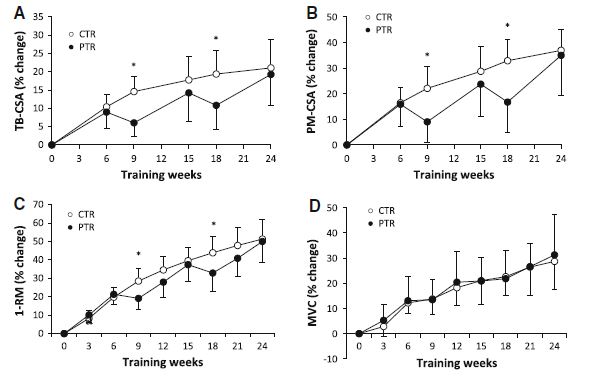HST_Rihad
Active Member
http://weightology.net/weightologyweekly/?page_id=4705
A nice research showing how a group utilizing 3-week long SD (called by them periodic training) midway through weight progression in bench presses soon catches up with the continuous training group, and by the end of the 24-week long survey their results are very similar despite 2 3-week long breaks done by one of the groups (i.e. 6 weeks less of training).

Notice the diminishing returns shown by the constantly training group and how the SD group shows no such decline? It's very probable that had they done a third go the SD group would have shown better gains.
Another interesting point is loads and volume used: the subjects worked 3 times per week with their 75% bench press loads (~10-11RM) for 10 reps in 3 sets with 2-3 minute rest in between, and if they could push 12 or more reps in the third set, there was an obligatory 5% increase for the next session. It's interesting that not going above 10RM was enough to achieve consistent growth. I think I will have my next cycle stop at 10RM loads and let any strength increases govern when load should be increased, stopping for SD every 6 weeks. This has the advantage of not dragging the workout for too long, as heavier 5RM loads would for no apparent reason.
A nice research showing how a group utilizing 3-week long SD (called by them periodic training) midway through weight progression in bench presses soon catches up with the continuous training group, and by the end of the 24-week long survey their results are very similar despite 2 3-week long breaks done by one of the groups (i.e. 6 weeks less of training).

Notice the diminishing returns shown by the constantly training group and how the SD group shows no such decline? It's very probable that had they done a third go the SD group would have shown better gains.
Another interesting point is loads and volume used: the subjects worked 3 times per week with their 75% bench press loads (~10-11RM) for 10 reps in 3 sets with 2-3 minute rest in between, and if they could push 12 or more reps in the third set, there was an obligatory 5% increase for the next session. It's interesting that not going above 10RM was enough to achieve consistent growth. I think I will have my next cycle stop at 10RM loads and let any strength increases govern when load should be increased, stopping for SD every 6 weeks. This has the advantage of not dragging the workout for too long, as heavier 5RM loads would for no apparent reason.
